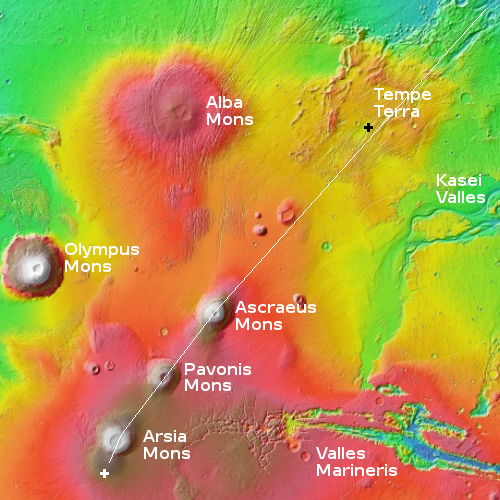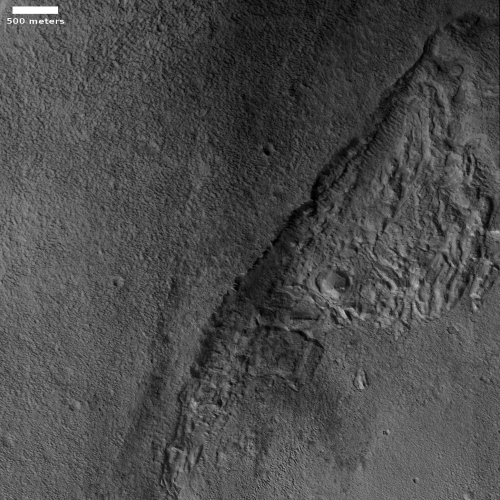On Mars you can find glaciers everywhere in the mid-latitudes
Cool image time! If you ever decide to have some fun exploring the archive of images being sent back to Earth by the high resolution camera on Mars Reconnaissance Orbiter (MRO), always remember that the latitude of the image will almost immediately help to explain the strange features that you see in each picture.
The hi-res photo to the right, rotated, cropped, and reduced to post here, was taken on May 22, 2022 and provides us a great example. The jumbled features in the depression on the image’s right half surely look like the glacial features seen routinely in the 2,000-mile-long strip found in the 30 to 60 degree band in the chaos terrain of the northern lowland plains. In fact, it is likely that cycles of ebb and flow of those glaciers helped shape this chaos of buttes and mesas and cross-cutting canyons.
This picture however is nowhere near any chaos terrain, or that 2,000 long strip. In fact, it is instead in an area that appears mostly formed by tectonic and volcanic activity, as the overview map below shows.

The black cross marks the location of this glacial material, in one of the many parallel cracks that form the region dubbed Tempe Terra. The white line delineates the most important of these rifts, the one that cuts through the giant volcanoes of Mars and thus acted as a release for their eruptions.
The depression itself above is just one of those rifts, formed when the pressure of magma below pushed up and cracked the surface layers above.
Yet, it is almost certain the jumbled stuff in the depression is glacial, not frozen lava. I say this not simply because it looks like glacial material, but because the latitude of this depression, at 38 degrees north, strongly suggests that this is what it is. It sits right inside the mid-latitude band where such glacial features are common.
In this case the ice appears to have migrated into the depression, where it appears to have been slowly sublimating away over time.
On Christmas Eve 1968 three Americans became the first humans to visit another world. What they did to celebrate was unexpected and profound, and will be remembered throughout all human history. Genesis: the Story of Apollo 8, Robert Zimmerman's classic history of humanity's first journey to another world, tells that story, and it is now available as both an ebook and an audiobook, both with a foreword by Valerie Anders and a new introduction by Robert Zimmerman.
The print edition can be purchased at Amazon or from any other book seller. If you want an autographed copy the price is $60 for the hardback and $45 for the paperback, plus $8 shipping for each. Go here for purchasing details. The ebook is available everywhere for $5.99 (before discount) at amazon, or direct from my ebook publisher, ebookit. If you buy it from ebookit you don't support the big tech companies and the author gets a bigger cut much sooner.
The audiobook is also available at all these vendors, and is also free with a 30-day trial membership to Audible.
"Not simply about one mission, [Genesis] is also the history of America's quest for the moon... Zimmerman has done a masterful job of tying disparate events together into a solid account of one of America's greatest human triumphs."--San Antonio Express-News
Cool image time! If you ever decide to have some fun exploring the archive of images being sent back to Earth by the high resolution camera on Mars Reconnaissance Orbiter (MRO), always remember that the latitude of the image will almost immediately help to explain the strange features that you see in each picture.
The hi-res photo to the right, rotated, cropped, and reduced to post here, was taken on May 22, 2022 and provides us a great example. The jumbled features in the depression on the image’s right half surely look like the glacial features seen routinely in the 2,000-mile-long strip found in the 30 to 60 degree band in the chaos terrain of the northern lowland plains. In fact, it is likely that cycles of ebb and flow of those glaciers helped shape this chaos of buttes and mesas and cross-cutting canyons.
This picture however is nowhere near any chaos terrain, or that 2,000 long strip. In fact, it is instead in an area that appears mostly formed by tectonic and volcanic activity, as the overview map below shows.

The black cross marks the location of this glacial material, in one of the many parallel cracks that form the region dubbed Tempe Terra. The white line delineates the most important of these rifts, the one that cuts through the giant volcanoes of Mars and thus acted as a release for their eruptions.
The depression itself above is just one of those rifts, formed when the pressure of magma below pushed up and cracked the surface layers above.
Yet, it is almost certain the jumbled stuff in the depression is glacial, not frozen lava. I say this not simply because it looks like glacial material, but because the latitude of this depression, at 38 degrees north, strongly suggests that this is what it is. It sits right inside the mid-latitude band where such glacial features are common.
In this case the ice appears to have migrated into the depression, where it appears to have been slowly sublimating away over time.
On Christmas Eve 1968 three Americans became the first humans to visit another world. What they did to celebrate was unexpected and profound, and will be remembered throughout all human history. Genesis: the Story of Apollo 8, Robert Zimmerman's classic history of humanity's first journey to another world, tells that story, and it is now available as both an ebook and an audiobook, both with a foreword by Valerie Anders and a new introduction by Robert Zimmerman.
The print edition can be purchased at Amazon or from any other book seller. If you want an autographed copy the price is $60 for the hardback and $45 for the paperback, plus $8 shipping for each. Go here for purchasing details. The ebook is available everywhere for $5.99 (before discount) at amazon, or direct from my ebook publisher, ebookit. If you buy it from ebookit you don't support the big tech companies and the author gets a bigger cut much sooner.
The audiobook is also available at all these vendors, and is also free with a 30-day trial membership to Audible.
"Not simply about one mission, [Genesis] is also the history of America's quest for the moon... Zimmerman has done a masterful job of tying disparate events together into a solid account of one of America's greatest human triumphs."--San Antonio Express-News


